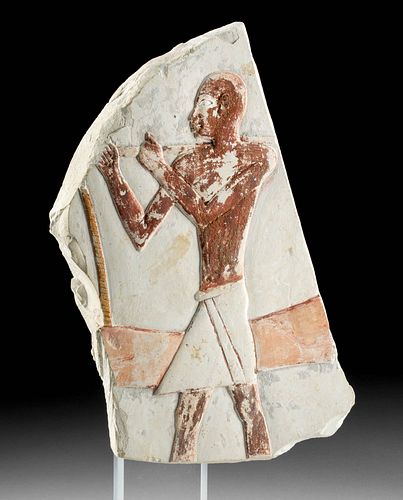Egyptian Polychrome Limestone Relief Panel w/ Figure
Lot 3a
About Seller
Artemis Fine Arts
686 S Taylor Ave, Ste 106
Louisville, CO 80027
United States
Selling antiquities, ancient and ethnographic art online since 1993, Artemis Gallery specializes in Classical Antiquities (Egyptian, Greek, Roman, Near Eastern), Asian, Pre-Columbian, African / Tribal / Oceanographic art. Our extensive inventory includes pottery, stone, metal, wood, glass and textil...Read more
Categories
Estimate:
$20,000 - $30,000
Absentee vs Live bid
Two ways to bid:
- Leave a max absentee bid and the platform will bid on your behalf up to your maximum bid during the live auction.
- Bid live during the auction and your bids will be submitted real-time to the auctioneer.
Bid Increments
| Price | Bid Increment |
|---|---|
| $0 | $25 |
| $300 | $50 |
| $1,000 | $100 |
| $2,000 | $250 |
| $5,000 | $500 |
| $10,000 | $1,000 |
| $20,000 | $2,500 |
| $50,000 | $5,000 |
| $100,000 | $10,000 |
| $200,000 | $20,000 |
About Auction
By Artemis Fine Arts
Mar 24, 2022
Set Reminder
2022-03-24 10:00:00
2022-03-24 10:00:00
America/New_York
Bidsquare
Bidsquare : Exceptional Antiquities Ethnographic Fine Art
https://www.bidsquare.com/auctions/artemis-gallery/exceptional-antiquities-ethnographic-fine-art-9057
Museum-worthy examples of classical antiquities (Egyptian, Greek, Roman, Near Eastern), Viking, Far East / Asian, Pre-Columbian, African / Tribal, Oceanic, Native American, Spanish Colonial, Fossils, Ancient Jewelry, Fine / Visual Arts, so much more! Artemis Fine Arts info@artemisfinearts.com
Museum-worthy examples of classical antiquities (Egyptian, Greek, Roman, Near Eastern), Viking, Far East / Asian, Pre-Columbian, African / Tribal, Oceanic, Native American, Spanish Colonial, Fossils, Ancient Jewelry, Fine / Visual Arts, so much more! Artemis Fine Arts info@artemisfinearts.com
- Lot Description
Ancient Egypt, Middle Kingdom, 11th to 13th Dynasty, ca. 2130 to 1649 BCE. An astounding limestone panel hand-carved in low relief to depict a male figure facing left, expertly hand-painted in hues of brown, pink, and ochre atop the creamy beige limestone. Likely part of an agricultural or labor scene, the ancient figure presents a slender body wrapped in a short, shendyt kilt suspended by a belt at the top as it dramatically flares out, pushed forward by his hearty stride. His narrow waist is sharply contrasted by broad shoulders on which he balances a thin, wooden carrying pole. He holds both arms out in front of him, each bending at the elbow to tightly grasp the pole as he gazes forward, fully absorbed on the task before him. Shown in profile, his hairless head displays a stern visage comprised of a large, elongated eye, a sharp nose, fleshy lips, and a naturalistic ear. Size: 5.5" W x 8.5" H (14 cm x 21.6 cm); 11.2" H (28.4 cm) on included custom stand.
A woven rope falls from his carrying pole, acting as a suspension for the sizeable, lengthy object at his side, likely a slab of wood for constructing a boat as carrying poles were frequently used by laborers in lumberyards of Ancient Egypt.
Raised reliefs are some of the most famous art from ancient Egypt. They lined the walls of tombs, temples, and palaces, and have a specific visual style of two-dimensional, profile figures that persisted in Egypt for centuries. Artisans created them in several steps. First, they carved the scene in low relief. Next, they divided the drawing surface into a grid using string coated in red pigment dust. Archaeologists have found models divided into grids to help artists better understand proportions on these often-large works. The painting was then done a single color at a time. Egyptian pigments came from local minerals, and red came from iron oxides ground and mixed with a plant- or animal-based glue that would adhere to sandstone.
The carved (rather than simply painted) and brightly colorful nature of this relief indicates that it was from a prestigious location - most likely a major temple, but also possibly a high-ranking official's tomb or even a palace. Images like this one were part of larger stories, usually a journey through the afterlife or meeting deities in the afterlife, that were designed to help people understand religious concepts and, if found in a tomb, to introduce the dead to their new world.
Provenance: private East Coast collection, New York, New York, USA, acquired before 2010
All items legal to buy/sell under U.S. Statute covering cultural patrimony Code 2600, CHAPTER 14, and are guaranteed to be as described or your money back.
A Certificate of Authenticity will accompany all winning bids.
PLEASE NOTE: Due to recent increases of shipments being seized by Australian & German customs (even for items with pre-UNESCO provenance), we will no longer ship most antiquities and ancient Chinese art to Australia & Germany. For categories of items that are acceptable to ship to Australia or Germany, please contact us directly or work with your local customs brokerage firm.
Display stands not described as included/custom in the item description are for photography purposes only and will not be included with the item upon shipping.
#170774Fragment of a larger piece. Repaired from a few pieces with light restoration and repainting over break lines. Chipping to peripheries. Some expected nicks and abrasions. Otherwise, excellent with impressive remaining pigments and detail.Condition
- Shipping Info
-
All shipping is handled in-house for your convenience. Your invoice from Artemis Gallery will include shipping calculation instructions. If in doubt, please inquire BEFORE bidding for estimated shipping costs for individual items.
-
- Buyer's Premium



 EUR
EUR CAD
CAD AUD
AUD GBP
GBP MXN
MXN HKD
HKD CNY
CNY MYR
MYR SEK
SEK SGD
SGD CHF
CHF THB
THB














